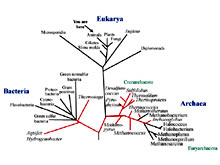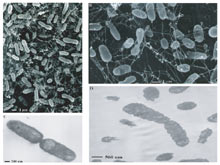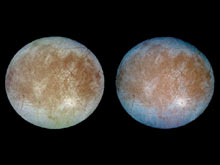
All life on Earth is divided into three major domains: Bacteria, Archaea, and Eukarya. This is the universal phylogenetic tree based on a gene that we all have, the ribosomal RNA. We (humans) are located in the crown group of animals, but the majority of diversity on this planet is in the microbial (bacterial and archaeal) world. Those lines highlighted in red lead to organisms that are heat-loving, the focus of much of our work at deep-sea hydrothermal vents. Click image for larger view and image credit.
Microbiology
Julie Huber
NASA Astrobiology Institute Postdoctoral Fellow
Marine Biological Laboratory — Woods Hole, Massachusetts
Microbes everywhere
The world's oceans are teeming with microscopic life forms. Communities of bacteria, archaea, and fungi plus protists account for greater than 90% of oceanic biomass and 98% of primary production. Although they are largely invisible to the naked eye, microorganisms are pervasive in all marine environments, where they have had a profound impact on Earth's habitability and biodiversity. Yet their diversity and distribution remain under-sampled and uncharted, including those at deep-sea hydrothermal vents.
The base of the food chain
Hydrothermal vents were discovered in the late 1970s. Since then, research has shown that microbes are ubiquitous in and around hot and warm sea-floor vents driven by volcanic heat. Microbes have the ability to capture energy from a huge range of chemical processes, and many of the microbes at deep-sea hydrothermal vents do not need sunlight or oxygen to survive. Some live off of sulfur, hydrogen, or iron, while others produce methane. Many of these organisms fix their own carbon from the carbon dioxide being emitted in vent fluids, and they in turn serve as a carbon source for the larger creatures often seen at deep-sea vents, like tube worms or mussels. These microbes are considered the primary producers at vents, providing energy for all other life forms found there. The sea-floor vents system is fundamentally different from the photosynthetic light-driven ecosystem that most of us are familiar with at the surface of the ocean or in our backyard gardens.

Photomicrographs of a subseafloor thermophile (a life form that thrives in heat) isolated from deep-sea hydrothermal vent fluids. This organism eats sulfur and hydrogen and fixes its own carbon from carbon dioxide. Shown here are scanning electron micrographs (A,B) , and transmission electron micrographs thin sections (C, D). Click image for larger view and image credit.
Some like it hot
Other microbial members of the hydrothermal vent community are heat-loving, or thermophilic, meaning they grow at very high temperatures, from a "mild" 40°C (104°F) all the way up to 121°C (250°F)! Our research focuses on these high temperature organisms and how they interact with the complex and dynamic geochemical vent environment. We are especially interested in the subseafloor microbial community. The circulation of hydrothermal fluids and seawater occurs within the upper 500 m of porous oceanic crust and provides a rich environment for microbial growth beneath the sea floor. To access this "invisible" environment, we collect hydrothermal vent fluids as a window into the subseafloor habitat.
The western Mariana arc offers a unique opportunity to study the microbial populations at a completely different kind of submarine volcanic system compared with more "traditional" mid-ocean ridge or hot spot systems. The Mariana seamounts are at a convergent plate boundary and host a variety of fluids, including those with very low pH and high concentrations of particulate sulfur; and, therefore, the seamounts may host a different microbial community. Preliminary work at these sites in 2004 found evidence of acidophiles (organisms that thrive at low pH), including some relatives of organisms generally found to inhabit the much more neutral fluids at mid-ocean ridges.
Based on this data, we have designed new media to culture low pH organisms, as well as those dependent on elemental sulfur and carbon dioxide. However, because many vent organisms are difficult or nearly impossible to culture, we will also expand upon the molecular-biology DNA-based approaches begun in 2004 to study this "extreme" microbial community. This includes directed approaches for determining the microbial diversity of the population, as well as more advanced genomic approaches that allow us to determine the genetic and functional composition of the microbial community.

This image shows two views of the trailing hemisphere of Jupiter's ice-covered satellite, Europa. The left image shows the approximate natural color appearance of Europa. The image on the right is a false-color composite version to enhance color differences in the predominantly water-ice crust of Europa. There are a number of very good lines of evidence which suggest that beneath this icy cover lies an ocean — and many have speculated that if there is an ocean, there could be hydrothermal vents (and maybe even microbes!). Click image for larger view and image credit.
From the beginning to space?
Finally, our interest in hydrothermal vent microbial communities spans much further than the bottom of the ocean. Some scientists hypothesize that life may have originated and evolved near deep-sea hydrothermal systems, and that organisms currently living in these likely analogues of early habitats may still harbor characteristics of early life. Microbes unique to this environment could provide insight into metabolic processes, strategies for growth, and survival of life forms in the subsurface of solar bodies with a water history.
For example, Jupiter's satellite Europa may harbor a liquid ocean with life-supporting hydrothermal systems beneath its icy shell. And the recent detection of methane in the Mars atmosphere has brought considerable attention to methane generation, both abiotic (not relating to life) and biotic (relating to life); and, in general, determining if Mars can feasibly support microbial metabolisms that use or generate methane.
With a sample size of only one, the search for life beyond Earth must begin with life as we know it on Earth, and deep-sea hydrothermal vents are a great place to begin our search for unusual life forms that push the limits of life as we know it.
Sign up for the Ocean Explorer E-mail Update List.



























